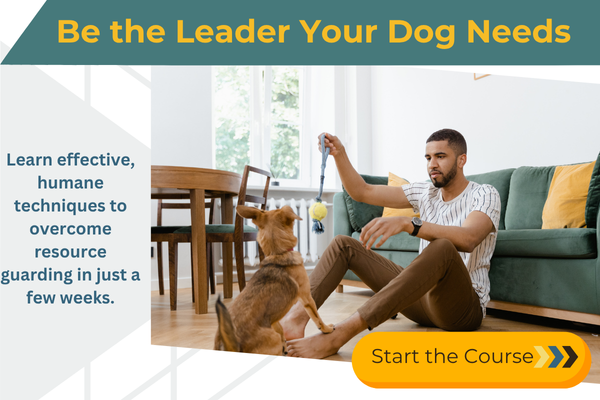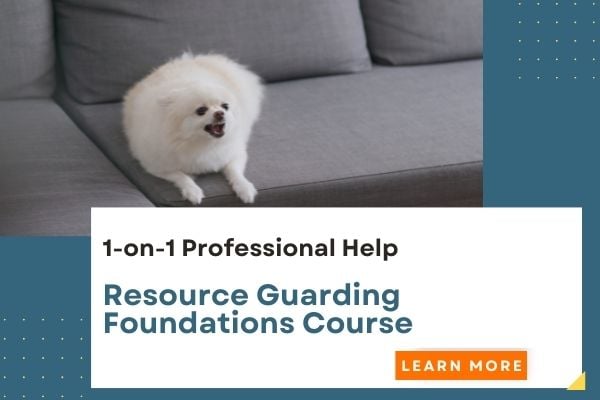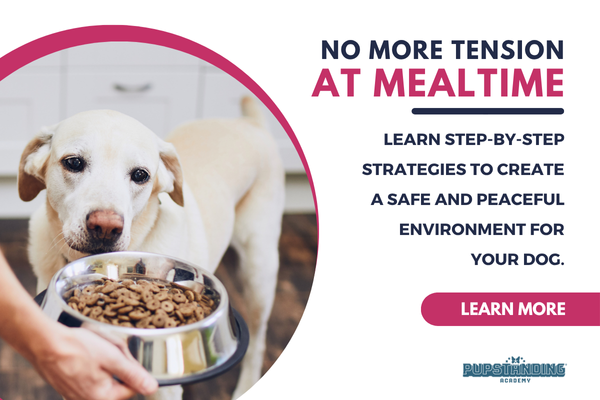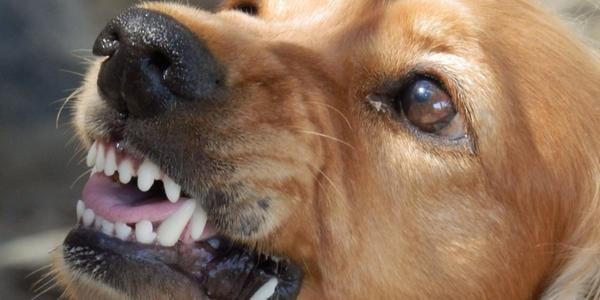 Resource guarding in dogs, also called "possessive aggression," can be quite alarming and scary for a dog owner to experience.
Resource guarding in dogs, also called "possessive aggression," can be quite alarming and scary for a dog owner to experience.
You go to grab a chew that your dog has whittled down to a tiny piece, so they don't swallow it — but are confronted with teeth-baring, growling, or even lunging and biting.
Or perhaps you go to sit down next to your dog on the couch and get a hard stare and a low growl.
This can — and should — send a chill down your spine.
Resource guarding can happen between pets as well. A dog may show food aggression if another dog walks by. Or they might even guard you from the other dog, especially if there are food items or toys involved. If you've recently brought home a new puppy or adopted dog, your other dog might be showing some new aggressive behaviors around their toys and food.
What should you do if your dog is guarding their food bowl, chew toy, or space? Your reaction to the behavior can either help resolve your dog's resource guarding or make it worse. Let's look at why resource guarding in dogs happens, what you should do to prevent it, and what to do if your dog exhibits resource guarding.
Table of Contents
What Is Resource Guarding?
Resource guarding is when a dog reacts when they perceive a threat to a valuable resource in their possession. The dog feels they are about to lose something and takes action to keep it. Resource guarding does not always have to end with growling, lunging, biting, or fighting. Patricia McConnell defines it well as "any behavior that discourages another to take, or get too close to, an object or valued area in the dog's possession.1" This behavior could be as simple as a look, head turn, or slight baring of the teeth.
Guarding resources is a natural dog behavior. It's a natural animal behavior — humans included! Access to resources like food, water, and a safe space is essential to survival. It's hardwired into animal nature to protect the things we believe we need to survive.
While resource guarding is a normal dog behavior, it's not a desirable one. Resource guarding becomes a dangerous problem if a dog is willing to bite or fight to keep an item. Aggression around food, toys, or space, can result in dog bites to humans or fights between your pets. This is especially worrisome in a home with young children, elderly family members, or if the dog is not predictable in what items or when they decide to guard.
Common Items That Trigger Resource Guarding in Dogs
While most often seen around food items, a dog can develop resource guarding with any item that they deem "valuable." This might be something we don't consider very important, like a sock, but that sock could be your dog's most beloved possession. That sock might be the Ring to their Gollum. In one behavior case, a client's dog would guard the open dishwasher and react whenever the owners tried to close the dishwasher door.
Food Aggression
- Food and Treats
- Food Bowl (filled with food or empty)
- Bones and Edible Dog Chews
Non-Food Aggression
- Toys
- Stolen "contraband" (tissues, napkins, socks or laundry items, shoes)
- Space (dog bed, crate, their position on the couch or bed, their feeding area)
- Their owner* (from other pets in the home or even from other people)
*Behavior Note: Many dog owners assume that their dog is "protecting" or resource guarding them when their dog is exhibiting barking or lunging towards people approaching them when on leashed walks. Often, this behavior is actually leash reactivity or fear-based aggression and not true resource guarding.
Take Our Resource Guarding Survey:
We appreciate you participating in this survey, and as a thank-you gift upon completion, you'll receive a special coupon code for a discount on our virtual Resource Guarding Foundations Course.
Your submissions are anonymous. Sharing your experience allows us to understand Resource Guarding better and allows us to create more resources to help anyone struggling with this issue.
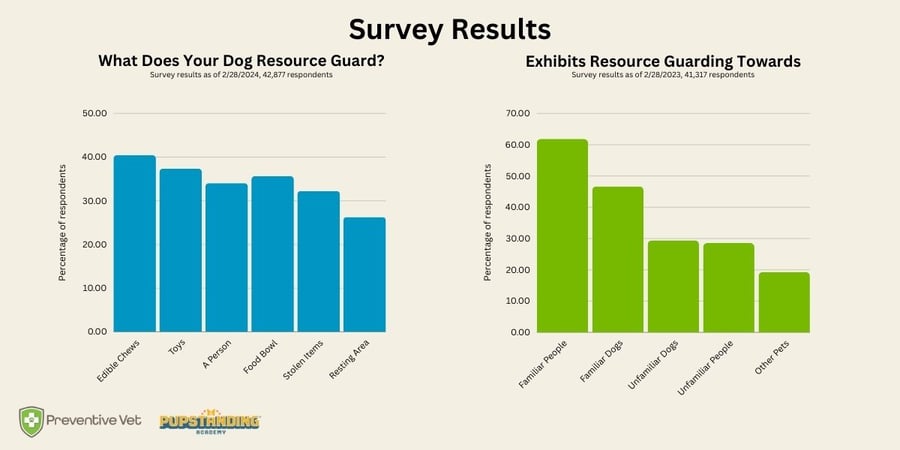
Signs of Resource Guarding in Dogs
These are the most obvious and intense signs of resource guarding. Unfortunately, too often, it isn't until a dog is doing these things that I get a call for help from the dog's owner:
- Growling
- Lunging and Air Snapping (a no-contact bite)
- Chasing you or another animal away
- Biting
In developing and "milder" cases of resource guarding, a dog might show less intense (and therefore less obvious) signs of guarding behavior. A certified dog trainer, veterinary behaviorist, behavior consultant, or someone with experience reading dog body language will often see these more subtle signs prior to the actions described above:
- Freezing (very short or longer pauses or tension in the body)
- Eating faster
- Taking an item and moving away
- Braced body position over the item
- Subtle shifting of body weight to "block" the item
- Side eye staring or tracking of the person or pet approaching
- Raising lips and baring teeth
- Ears pinned flat against the head
- Hard stare
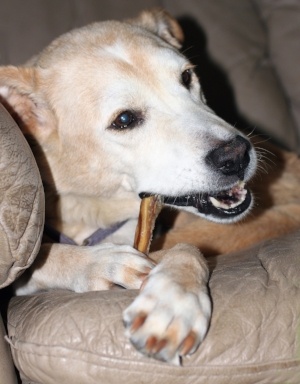
What Causes Resource Guarding in Dogs?
You may feel confused by why your dog is exhibiting food aggression or guarding other items, especially if you've worked hard on early socialization and feel like you always provide more than enough resources for them.
Remember — resource guarding is a normal and natural dog behavior!
Resource guarding in and of itself should not be surprising. However, the intensity with which a dog guards their food, items, or space can be affected by other contributing factors, such as:
- Genetics: A dog's breed or breed mix may have predispositions for increased guarding behavior.
- History of resource scarcity: Lack of resources in previous homes or environments may increase guarding behavior. However, this isn't as common as many people assume. There are many dogs who came from resource-scarce situations who have no resource guarding issues, and dogs who never lacked anything that guard food or other items.
- Stress: When a dog is stressed, guarding behavior may increase. This stress could be due to guests in the home, new family members (human or animal), or other stress-inducing events, such as fireworks.
- Inherent Value: Food often has the highest inherent value, as food is necessary for survival. But every dog is different in what they find inherently valuable.
- Added Value: The added value of specific items is based on how we present, interact with, or take certain things. Have we made a big deal about this thing in the past? That can increase the value of the item and make it likely for a dog to guard in the future. This could be things like stolen socks from the laundry basket that we chase them down for and pull out of their mouth, or a brand new dog toy that we make a big deal over when first giving it to them. Novel or stolen items tend to have extra added value for most dogs.
- The Dog's Physical and Mental Needs: Not having their needs met can increase behavioral issues for dogs. It could be a longer-term issue, such as a lack of enrichment or exercise, or more of a short-term issue, like tiredness, hunger, or thirst. If a dog is hungry, they are often more likely to guard food items compared to when they are not hungry.
- Underlying Medical Issues: Pain can cause an increase in the frequency or intensity of aggressive behaviors. Be sure to have your veterinarian perform a comprehensive physical exam to rule out medical issues whenever you see a sudden change in behavior.
- Actions of the person or other animal. A dog can learn that guarding something is necessary because of what they've learned in the past. If someone has shown that they will walk over and take away a chew, a dog can learn that next time they need to warn that person off, exhibiting guarding behavior around chews in the future. How a dog is trained and how people act around resources and their dog have a direct impact on resource guarding behavior.
Any dog may exhibit intense guarding behavior, whether they are adopted from a rescue or received from a breeder. Dogs of any breed or breed mix can have resource guarding issues.
Resource Guarding Between Dogs or Other Animals
Dogs will guard resources from each other, or even other pets in the home, like cats. This is called dog-directed resource guarding (or animal-directed in the case of other species). Guarding behaviors could happen over a certain resting place, food bowls, or high-value chews and toys. When resources are limited, such as when there's only one chew but two dogs, we tend to see an increase in guarding. You may also see an increase in resource guarding when a new pet joins the home.
Here's an example of Mabel the Pug guarding the couch space from the household cat:
Fortunately, most dogs will gauge whether a particular resource is worth enough to fight over. There's no point in risking injury by fighting with another dog for something of lower value. Many dogs will communicate with each other using body language and vocalizations to express their desire for the thing the other dog has or to tell the other to leave them alone.
If you have a multi-dog household, you might see the ebb and flow of resource guarding "conversations" they have. This is called ritualized aggression. True aggression is an expensive behavior for dogs to engage in. It risks injury or worse, and most dogs want to avoid it if possible. They may posture and act "tough" but not back it up with true aggressive engagement with the other dog when push comes to shove. Ritualized aggression is part of normal dog communication but can indicate underlying stress and negative emotional associations.
For example, my dog Sookie is possessive of chews in the office. However, she is conflict-averse and gives low-level signals to the other dog, which means, "This chew is mine. Leave me alone." She'll take her chew further away, or I step in. It also helps that the humans in the office prevent an escalation of resource guarding by managing the situation and calling one dog away from another.
Here's a short video showing Sookie's displeasure towards fellow office pup Clover's hovering around a chew:
In multi-dog households or environments, resource guarding becomes a problem if the dogs resort to fighting over their resources and the environment is not managed to prevent these conflicts from escalating. If ritualized aggression crosses the line into true aggression (the intent to harm the other), it's crucial to address the issue to prevent injury and behavioral fallout.
If your dogs are getting into fights over resources, learn how to break up a dog fight safely here.
Treating Dog-Directed Resource Guarding
Addressing food aggression or other resource guarding behaviors between dogs follows a similar plan as human-directed resource guarding treatment. It can be more difficult, however, as the treatment plan requires managing multiple variables within the training setup.
Management is crucial! Dogs who exhibit food aggression towards another household dog (or even the household cat!) should always be fed in separate and secure areas. If a dog becomes aggressive towards another dog over toys, it's important to make sure that these toys are not just sitting willy-nilly around the house. For dogs who guard space from each other, blocking access to these areas outside of training and close supervision is imperative.
If your dog is food aggressive towards your other dog or pets or guards toys, space, or even you, connect with a certified behavior consultant to start working on changing this behavior and creating a more positive emotional response in these scenarios. This video shows a great overview of one behavior exercise that a consultant will personalize for your dogs:
Outside of management to prevent resource guarding between dogs and working in counterconditioning exercises to reduce instances of resource guarding, you'll also want to make sure the relationship between the two dogs is strengthened, if possible. Having shared experiences, where they get to do something together that they both enjoy, is important for relationships between dogs. But you have to be careful not to accidentally introduce potentially triggering resources. This is why it's best to work with a professional.
What NOT to Do if Your Dog Resource Guards
Don't Punish the Growl
Never punish a growling dog. You can punish away a growl, sure, but all you've done is make a dog bite more likely. If your dog learns that growling to express their discomfort at your approach results in an aversive (such as yelling, hitting, a "tap" from a shock collar), and the loss of the item they were guarding, the next time you reach for it, they're more likely to skip the growl and go straight for a bite.
If someone keeps stealing my fries after asking them to stop, the next time they reach across the table, I might smack their fingers away (or worse ... don't steal my fries).
Ignoring warnings (like growls) will escalate behavioral responses, in both humans and dogs. You don't want to take away important warning signs that your dog needs to communicate with you.
A dog growl is not a challenge to you or the dog being mean or bad. They are literally trying to communicate with you without escalating to a bite. Always listen to a growl by stopping your approach, taking a step back, and evaluating the situation so you can avoid it in the future and start treating the issue.
Don't "Play" With Their Food and Chews
So many clients come to me for help with resource guarding and tell me, "We wanted to prevent resource guarding, so we'd always stick our hands in our dog's food bowl while they were eating or randomly take away their chew. That way, they know who's boss and that the food or chew belongs to us." Instead of the desired result, they now have a dog who snaps when they reach for the bowl or a dog that lashes out even at just their walking by the bowl.
Without taking the necessary proactive and preventive steps (which I'll outline further below), sticking your hand in your dog's food bowl while they're eating or just taking away their chew toy will backfire. All you're doing is annoying your dog and teaching them that when you reach for something, they'll lose it. Not the association we want our dogs to make!
Check out and share this video about how we often create resource guarding in our dogs by playing with their food:
Don't Leave Out Items That Your Dog Might Guard
If your dog loves to grab socks from the laundry basket and then growls or tries to bite when you try to take them away, set yourself up for success from the get-go (and avoid the possible surgery to remove the sock foreign body) by removing the opportunity.
Once, I gave each of my dogs a new chew, a super smelly (and I'm assuming super delicious to dogs) lamb spine. They sat and enjoyed it for a while, and then I got up from my spot on the couch and walked past one of them to the kitchen. As I got near, I reached down — not to take the chew, but to give my dog a scratch on the neck — and I was greeted by a low, sustained growl.
I immediately stopped what I was doing, took a step back, and assessed the situation. This was the first time that my dog had shown resource guarding behavior toward me. And you know what I did? I called him into the kitchen and traded him some cheese for the chew, and then never bought those chews again. If only all my resource guarding cases were that simple.
What to Do If Your Dog Resource Guards
Sharing our lives with our dogs means that we need to make sure they feel okay with us approaching things they find valuable. There's no need to guard food, toys, or space if we teach them that our removing an item, such as their chew, results in something equal to or better than what they had.
Giving up something to us willingly and happily needs to be trained and rewarded for our dogs so that resource guarding doesn't become an issue.
Unfortunately, the collective human response to a dog who is resource guarding has been the wrong one for too long. Using punishment and aversives as a response to resource guarding can result in MORE resource guarding.
When you notice aggressive behavior developing around your dog's resources, it's important to address it as soon as possible and in the right way. The sooner you start treatment, the more effective and faster it goes. So, where do you start?
Connect With a Certified and Qualified Dog Trainer or Behavior Consultant
Before diving into ways you can start to address any resource guarding with your dog, I want to stress that working one-on-one with a certified dog trainer, behavior consultant, or veterinary behaviorist should be your first step. They will make sure you stay safe and that your dog gets the positive training they need to learn that there's no need to growl and guard certain items, and help you with management techniques.
I do not know your dog or your situation in-depth. I cannot know the severity of your dog's individual case without meeting with you and learning about your dog's behavioral history and current setup. Beyond recommending basic management for safety, it is difficult for any trainer or consultant to give you specific advice about your case without a one-on-one session.
Not only will your certified trainer build a trainer-client relationship with you and your dog, but they'll also be able to help you through the steps that I'll briefly outline below. Due to the potentially dangerous situations that resource guarding can create, it's important to keep safety first — both for you and your dog.
Want to connect? Get instant access to an expert-led course on fixing your dog's resource guarding and ask our certified dog trainer your questions. Click here
Manage the Environment
Make a list of all of the things your dog has become possessive over. Then think about how you can change the environment to remove access to these things or reduce the likelihood your dog will feel the need to guard when they have possession of it.
For example, one of my training clients had a dog who loved to grab kitchen knives off the counter and then would not want to give them back. Not necessarily something you want to be chasing after your dog to get!
The first step in his training was to block off his access to the kitchen. Voilá! He didn't have access to the knives and, therefore, couldn't grab them and take off. Once his environment was managed, we then practiced things like Go to Bed while his owner cooked meals and the Drop It cue.
Examples of Management for Dogs Who Resource Guard
- Don't leave items (toys, shoes, etc.) lying around that your dog might find valuable enough to guard.
- Keep your laundry basket up high.
- Pick up their food bowls between meals after they've finished eating and have walked away.
- Feed your dogs in separate and secure areas away from each other.
- Don't give them certain toys or high-value edible chews that they have shown a tendency to guard in the past.
- Don't allow your dog on your bed or other furniture if they tend to guard that space.
- Don't free-feed your dog.
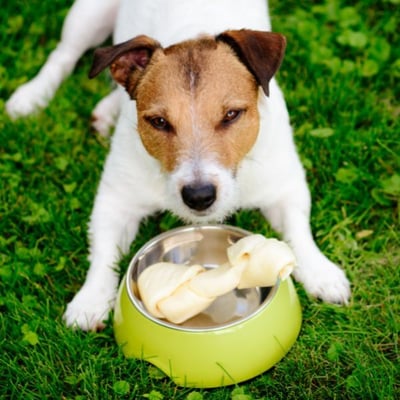
Let Your Dog Eat (and Chew) in Peace
For things that you can't just remove from your dog's environment, think about managing the context. If your dog guards their food bowl, set up a separate area where they can eat in peace. Do not free-feed your dog, and put away the bowl in a cupboard between meals.
Use a gate to block off your dog's feeding area during mealtimes so that no one can approach and make your dog feel the need to react. This is imperative if you have young children or elderly parents in the home who might not understand that they can't pet your dog during mealtimes. Blocking off separate feeding areas is also important if you have more than one dog, and one shows inappropriate resource guarding behavior.
If your dog guards things like a chew or long-lasting treat, give these to them in their safe space, crate, or other areas where they won't be bothered, and let them enjoy it in peace. Ensure that everyone in your home knows that if the dog is eating or enjoying a chew, they are to let them be. If it's difficult to confine your dog to a safe area while they enjoy their chew, or you are worried about a choking risk, then simply stop giving chews to them.
Start Desensitization and Counterconditioning Training
This step is the bread and butter of changing resource guarding behavior. Because it's easy for us to rush through the process, your dog trainer should be involved in every step. The goal is to change your dog's emotional response to your approach and the removal of the item they usually guard. Instead of the dread and fear of losing it, we want them to think, "Oh, goodie! She's coming over here, and that means something awesome is about to happen!" In the following section, I'll explain the basics of this process.
How to Begin Training for a Dog's Resource Guarding
For safety, it's best to connect with a certified dog trainer or behavior consultant before starting these exercises. You may need to implement safety measures into this practice, such as working from behind a baby gate or ex-pen – this is depending on your dog's case severity and bite risk. Remember, desensitization and counterconditioning training for resource guarding takes time and repetition!
- Find a high-value treat that your dog loves more than the thing they are guarding. Usually, moist and smelly works best, such as small pieces of chicken or turkey hotdog.
- Know the distance at which your dog begins to resource guard. Trainers may call this the "distance threshold." Some dogs don't get possessive of their item or food until you're a few feet away. Others get tense if you're even in the same room while they eat. The goal here is to find the distance at which they know you are there but aren't becoming tense or reacting with guarding behavior.
For example, if your dog begins eating faster when you're three feet away, start this exercise from four feet away. You're determining what their distance threshold is for guarding a resource. - Give your dog their meal or chew as usual, then walk away.
- Approach your dog, but stop a short distance beyond their distance threshold. Toss a piece of chicken to them. Once they eat it, toss another. Do this a few times, then turn and leave.
- Continue this exercise anytime your dog has something they guard.
- After a few sessions, begin to add one more step towards them before tossing the treat, and then step back. This is where you're decreasing their distance threshold. Don't rush this step.
- If your dog gets tense or shows other signs of resource guarding, take the training back a step.
Think about working in small "slices" when treating your dog's resource guarding. Don't rush through the process and just reach for their bowl — that's setting them up to fail, and you might get bit. To see these steps in action, watch this video about resource guarding and food aggression from 4Paws University:
With practice and consistency, your dog will learn to anticipate good things when you approach them. In many cases, these dogs choose to leave their food bowl or chew to happily approach you. When before they might stiffen or growl at your approach, with treatment, they instead show loose bodies and happy soft faces in anticipation of something good. This change in body language is the gauge by which we behavior consultants know if the treatment is progressing as expected.
Want help putting these strategies into action?
Check out our Resource Guarding Foundations Course — in-depth personalized help to safely manage and reduce guarding behaviors. Click here
Helpful Training Skills for Dogs Who Resource Guard
Teach Your Dog to Drop It and Leave It
Both the drop it and leave it cues are important skills for all dogs to learn, but especially those that struggle with resource guarding. Drop it means to let go of something that's already in their mouth or possession, and leave it means to turn away from something.
Click here to learn how to teach your dog to drop it. If your dog guards food items, start practicing drop it with toys and then move on to practicing food trades. If they drop a low-value chew, they get a high-value treat. Make sure you're rewarding with something equal or better!
Click here to learn how to teach your dog to leave it. Using a reward of equal or higher value to your dog will help speed up the training practice and increase your success with the leave it cue.
Teach Your Dog to Come When Called
Training a reliable recall with your dog is useful for preventing resource guarding behavior. You can call them away from something that they have rather than approaching them and trying to grab it. Click here to learn how to teach your dog to come when called.
Teach Your Dog to Go to Place
If your dog guards a particular place, such as a spot on the couch or your bed, creating a go to place cue means you can ask them to move to another designated spot where they will not be disturbed. This is often termed "stationing" by trainers. Having a behavior like this on cue means you do not need to physically guide your dog to a different space – keeping you safe and helping to prevent your dog from practicing unwanted guarding behaviors. Click here to learn how to teach your dog to go to place.
Preventing Resource Guarding from Developing in Puppies
The process of preventing resource guarding isn't much different from the tips outlined above. Prevention is always easier than treatment! Set your puppy or new dog up for success and see lots of proactive training exercises you can do in my article How to Prevent Resource Guarding.
More Resource Guarding Resources:
- "Resource Guarding: Treatment and Prevention" by Patricia McConnell
- Mine! A Practical Guide to Resource Guarding in Dogs by Jean Donaldson
- Podcast: Michael Shikashio "Resource Guarding, Aggression, and Reactivity"
- "Will Peeing on Your Dog Fix His Resource Guarding Problem?" by Michael Shikashio
- Resource Guarding Foundations Course with Cathy Madson
What does your dog resource guard? Their food bowl or a particular chew or toy? Tell us in the comments below!


